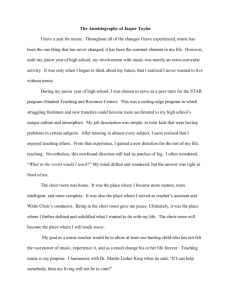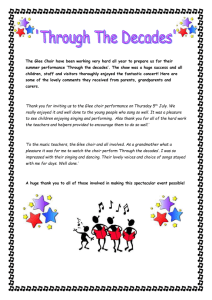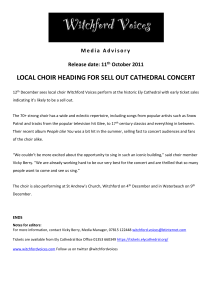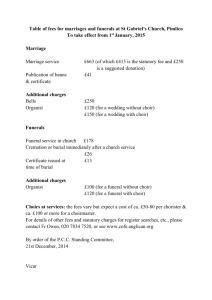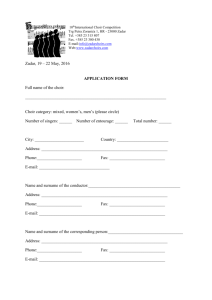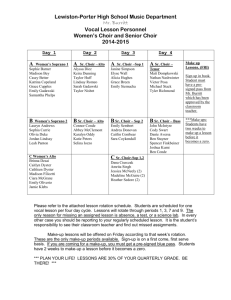Media:Prog_03_12_v11cBS
advertisement
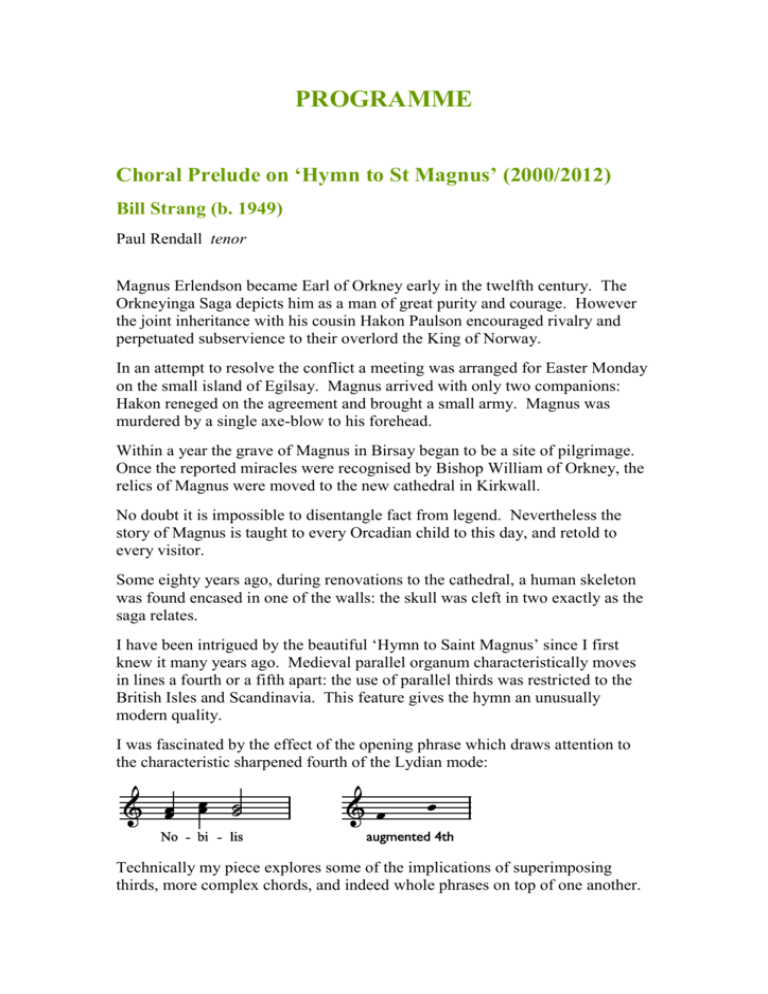
PROGRAMME Choral Prelude on ‘Hymn to St Magnus’ (2000/2012) Bill Strang (b. 1949) Paul Rendall tenor Magnus Erlendson became Earl of Orkney early in the twelfth century. The Orkneyinga Saga depicts him as a man of great purity and courage. However the joint inheritance with his cousin Hakon Paulson encouraged rivalry and perpetuated subservience to their overlord the King of Norway. In an attempt to resolve the conflict a meeting was arranged for Easter Monday on the small island of Egilsay. Magnus arrived with only two companions: Hakon reneged on the agreement and brought a small army. Magnus was murdered by a single axe-blow to his forehead. Within a year the grave of Magnus in Birsay began to be a site of pilgrimage. Once the reported miracles were recognised by Bishop William of Orkney, the relics of Magnus were moved to the new cathedral in Kirkwall. No doubt it is impossible to disentangle fact from legend. Nevertheless the story of Magnus is taught to every Orcadian child to this day, and retold to every visitor. Some eighty years ago, during renovations to the cathedral, a human skeleton was found encased in one of the walls: the skull was cleft in two exactly as the saga relates. I have been intrigued by the beautiful ‘Hymn to Saint Magnus’ since I first knew it many years ago. Medieval parallel organum characteristically moves in lines a fourth or a fifth apart: the use of parallel thirds was restricted to the British Isles and Scandinavia. This feature gives the hymn an unusually modern quality. I was fascinated by the effect of the opening phrase which draws attention to the characteristic sharpened fourth of the Lydian mode: Technically my piece explores some of the implications of superimposing thirds, more complex chords, and indeed whole phrases on top of one another. Programmatically it follows broadly the events of the Magnus legend referred to in the text of the hymn. The piece was originally written for chorus, brass ensemble, percussion and organ. It has been revised for the resources otherwise available for today’s concert. The following ‘attempt at a fairly literal translation’ has been provided by Michael Street, who has incorporated contributions from Deirdre Paul. Nobilis, humilis, Magne, martyr stabilis, Habilis, utilis, Comes venerabilis Et tutor laudabilis tuos subditos Serva carnis fragilis Mole positos. Noble, humble, Magnus, steadfast martyr; Suitable, beneficial, Reverend comrade and praiseworthy protector; Watch over your subjects Spent by their load of feeble flesh. Preditus, Celitus Donno sancti spiritus; Vivere Temere Summo caves opere; Presiding, heavenly, By the gift of the Holy Spirit; Through divinely inspired labour You guard against living without purpose; You take great pains to curb the impulses of the flesh, So that the Spirit may reign in the prison of the body. Carnis motus premere Studes penitus; Ut carnis in carcere Regnet spiritus. Turbidus Invidus Hostis Haco calidus; Sternere Terere Tua sibi subdere; Te cupit et perdere Doli spiculo; Iuncto fraudis sedere Pacis osculo. Wild, envious, Cunning enemy Hacon; He longs to lay you low, grind you down, Bring your property under his control, Destroy you with the sting of his deceit; To seal it with a kiss of false peace. Gravia Tedia Ferens pro iusticia Raperis Traheris Demum ictu funeris; Ab ymis extoleris Ad celestia; Sic Christo coniuneris Per supplicia. Suffering bitter weariness for the sake of justice, You are snatched, dragged off, At last, by a fatal blow; You will be raised up from Hell to Heaven; So you will be united with Christ Through your martyrdom. Eya Gloria, Signorum frequentia; Canitur Agitur, Christus benedicitur; Et tibi laus redditur In ecclesia; O quam falix cernitur Hinc Orchadia. Hail! Gloria! A multitude of signs; Christ is celebrated, heeded, praised; To you also praise is offered in our church; Oh how fortunate Henceforth Orkney is distinguished. Deus misereatur nostri Robert Johnson (c.1500–c.1560) Deus misereatur nostri et benedicat nobis; illuminet vultum suum super nos et misereatur nostri ut cognascamus in terra viam tuam, in omnibus gentibus salutare tuum; confiteantur tibi populi Deus, confiteantur tibi populi omnes. God be merciful unto us and bless us and cause his face to shine upon us and be gracious unto us: that thy way may be known upon earth, thy saving health among all nations. Let the people praise thee, O God; let all the people praise thee. Letentur et exsultent gentes quoniam iudicas populos in equitate et gentes in terra dirigis. Confiteantur tibi populi Deus, confiteantur tibi populi omnes; terra dedit fructum sum. O let the nations rejoice and be glad and sing for joy: for thou shalt judge the people righteously, and govern the nations upon earth. Let the people praise thee, O God: let all the people praise thee. Then shall the earth bring forth her increase; Benedicat nos Deus, Deus noster, benedicat nos Deus, et metuant eum omnes fines terrae. And God, even our own God, shall bless us. God shall bless us, and all the ends of the world shall fear him. Psalm 67 (Vulgate) (Authorised Version) Richt soir opprest Anon. 16th century Rich soir opprest am I with paines smart Both night and day makand my woeful moan To Venus quein, that ladie hes my heart Put in so gret distress with wo begone. Bot gif that she send me remeid anone I list no langer my lyf till induir Bot to the death bound cairfull creatour. Tho’ I dar nocht do daylie observance To hir that is the flour of womanheide Solace is caus of all this haill mischance And chaingit all my game in wo and deride. Bot gif that Ladie send me no remeide I list no langer my lyf till induir Bot to the death bound cairfull creatour. O plant of love with plesours infinet The lustiest that ever was or sall, Thair is no tongue can tell or pen can write The bewties of that fre in speciall. What sould I moir bot on my confort call To hir that hes my heart in cuir Bot to the death bound cairfull creatour. GLOSS bot gif: unless. cairfull: heavy with care. solace: the sport of love. sall: shall be. fre: noble lady. in cuir: in her keeping. William Bowie William Bowie in his M.Mus gown and hood photographed in the grounds of the Royal High School. From the school magazine Schola Regia, June 1970. William Bowie was born in 1925 in Edinburgh and educated at George Heriot’s School. In 1946 he was appointed to the staff of the music department of the Royal High School in Edinburgh. As well as teaching general class music and O-level and Higher ‘specialists’, for many years he was a prime mover in the organization of end-of-year concerts in the Usher Hall. These included extracts from choral-orchestral works by, for example, Purcell, Handel, Mozart and Stanford, as well as vocal and instrumental solos – and even occasionally compositions – by pupils. His own arrangements of Scottish folk-songs were frequently featured. He also established a reputation as an organist, first at St Columba’s Church, Blackhall and later at St George’s, Charlotte Square. When the large-scale concerts were disbanded in 1961, he fostered a smaller chamber choir which gave termly concerts of mainly Renaissance and modern repertoire, including a steady stream of anthems and part-songs of his own. This choir also shared concerts with his adult choir, St George’s Singers, and occasionally both joined the choirs of the city’s three cathedrals to form the Combined Edinburgh Choirs. Alongside these activities he continued his own studies. When he matriculated as a BMus student at Durham University in 1947 he had already gained qualifications from The Royal Academy of Music and The Royal College of Organists. He took his BMus degree in 1951. His MMus exercise, catalogued as Music Exercise 721 and comprising A Scottish Overture and Thomas the Rhymer was submitted on 23 October 1961. He took this degree in July 1962. It is ironic that, having instilled in so many of his charges a love of vocal music, he should have died of throat cancer while still in his prime, in 1970. A Scottish Overture (1961) world première William Bowie (1925–70) This piece, a specific requirement of the Master of Music syllabus at Durham University at the time, is clearly designed to demonstrate a grasp of symphonic sonata structure and orchestral technique. It starts with a distant side drum effect and a martial theme for the brass: A second theme, evidently intended to be taken at a broader tempo, is introduced by the string section: In this cleverly-constructed tune two syncopated gestures resolve on to a strong downbeat in the short-long rhythm characteristic of much Scottish dance music and known as the Scotch snap. The third theme is more lyrical: However, these second and third themes share a germ – a rising minor third followed by a rising major second – which will become more significant as the movement proceeds: Moreover, the positioning of these intervals in relation to the tonic, G, or to the predominant key at the time, produces a flattened seventh which ensures a modal inflection to the harmony which was already evident in the first theme and is reminiscent of much folk music. The overall structure unfolds along sonata form lines. The Development section itself is quite short but further significant development takes place in the Recapitulation section and there is a relatively long coda which finally resolves into G major. The De’il’s Awa’ (pub. 1955) William Bowie The De’il cam fiddlin thro’ the town, And danc’d awa’ wi’ th’ Exciseman, And ilka wife cried:— ‘Auld Mahoun, I wish you luck o’ the prize, man!’ Chorus The De’il’s awa’, the De’il’s awa’, The De’il’s awa’ wi’ th’ Exciseman! He’s danc’d awa’, he’s danc’d awa’, He’s danc’d awa’ wi’ th’ Exciseman! ‘We’ll mak our maut, and we’ll brew our drink, We’ll dance, sing, and rejoice, man, And monie thanks to the muckle black De’il, That danc’d awa’ wi’ th’ Exciseman! ‘There’s threesome reels, there’s foursome reels, There’s hornpipes and strathspeys, man, But the ae best dance ere cam to our land Was The De’il’s Awa’ wi’ th’ Exciseman!’ Robert Burns (1759-96) GLOSS ilka: every. Auld Mahoun: the Devil. maut: malt. muckle: big. ae: one. Despite his triumphant success as a published poet Burns still needed to earn a living. In September 1789 he began duty as an Excise Officer. So his joke is partly against himself. Thomas the Rhymer (1961) world première William Bowie Amanda Morrison soprano Paul Rendall tenor True Thomas lay on Huntlie bank; A ferlie he spied wi’ his ee; And there he saw a ladye bright Come riding down by the Eildon Tree. Her skirt was o’ the grass-green silk, Her mantle o’ the velvet fyne; At ilka tett o’ her horse’s mane, Hung fifty siller bells and nine. True Thomas he pu’d aff his cap, And louted low down to his knee ‘All hail, thou mighty Queen of Heaven! For thy peer on earth I never did see.’ ‘O no, O no, Thomas’ she said; ‘That name does not belang to me; I am but the Queen of fair Elfland, That am hither come to visit thee. ‘Harp and carp, Thomas,’ she said; ‘Harp and carp along wi’ me; And if ye dare to kiss my lips, Sure of your bodie I will be.’ ‘Betide me weal, betide me woe, That weird shall never daunton me.’ Syne he has kiss’d her rosy lips, All underneath the Eildon Tree. ‘Now, ye maun go wi’ me,’ she said, ‘True Thomas, ye maun go wi’ me; And ye maun serve me seven years, Thro’ weal or woe as may chance to be.’ She mounted on her milk-white steed, She’s ta’en true Thomas up behind; And aye, whene’er the bridle rung, The steed flew swifter than the wind. O they rade on, and farther on; The steed flew swifter than the wind; Until they reach’d a desert wide, And living land was left behind. ‘Light down, light down, true Thomas, And lean your head upon my knee; Abide and rest a little while And I will show you ferlies three. ‘O see ye not yon narrow road, So thick beset with thorns and briers? That is the path of righteousness, Though after it but few inquires. ‘And see ye not that braid braid road, That lies across that lily leven? That is the path of wickedness, Though some call it the path to Heaven. ‘And see ye not that bonny road, That winds about the fernie brae? That is the road to fair Elfland, Where thou and I this night maun gae. ‘But, Thomas, ye maun hold your tongue, Whatever ye may hear or see; For, if ye speak word in Elfyn land, Ye’ll ne’er get back to your ain countrie.’ O they rade on, and farther on, And they waded through rivers aboon the knee, And they saw neither sun nor moon, But they heard the roaring of the sea. It was mirk mirk night, and there was no stern light, And they waded through red blude to the knee; For a’ the blude that’s shed on the earth Rins through the springs o’ that countrie. Syne they came on to a garden green, And she pu’d an apple frae a tree— ‘Take this for thy wages, true Thomas; It will give thee the tongue that can never lie.’ ‘My tongue is my ain,’ true Thomas he said; ‘A gudely gift ye wad gie to me! I neither dought to buy or sell, At fair or tryst where I might be. William Bowie, Thomas the Rhymer, first choral entry, manuscript full score, bars 14-18 In Bowie’s manuscript, a note in pencil at the head of the poem says: The candidate respectfully claims a remote connection between himself, the school where he has been teaching for over 15 years, and the poet. Walter Scott, as a boy, was a pupil of the High School of Edinburgh, now the Royal High School. David Appleton and Bill Strang were also, at different times, pupils of William Bowie at the Royal High School and thus can claim a less remote, but nevertheless respectful, connection with this influential teacher. ‘I dought neither speak to prince or peer, Nor ask of grace from fair ladye.’ ‘Now hold thy peace!’ the lady said, ‘For as I say, so must it be.’ He has gotten a coat of the even cloth, And a pair of shoes of velvet green; And, till seven years were gane and past, True Thomas never on earth was seen. Sir Walter Scott (1771–1832) GLOSS ferlie: marvel. tett: tuft, lock. harp and carp: play and recite (as a minstrel). weird: destiny. daunton: frighten. leven: ?lawn. dought: could William Bowie’s setting of this poem is scored for soprano and tenor soloists, SATB chorus with divisions, and an orchestra comprising double woodwind, 4 horns, 2 trumpets, 3 trombones, timpani and strings. It is cast as a single movement lasting approximately 16 minutes. One musical theme is unequivocally associated with Thomas himself. It might be more accurate to call it a pitch shape, since it appears in many different rhythmic guises, but the definitive version may be the first choral entry: Another theme, most often assigned to a muted trumpet, is associated with the Queen of Elfland: Several elements of this theme are developed separately, the principle one being the short rhythm semiquaver-semiquaver-quaver: Conversely the Queen’s horse is represented by the opposite rhythm in a standard ‘oom-chacha’ accompaniment figure: The composer would use this accompanimental device again in his setting of Charles Causley’s ‘Cowboy Song’ (pub. 1968). When the Queen’s horse gets up some speed the accompaniment turns into a 6/8 gallop as in the part-song for male voices and piano ‘It was a’ for our righfu’ King’ (pub. 1965) in the series Harmonious Young Men (Songs for the use of). The score of William Bowie’s Durham degree exercises was located by David Appleton in 2010 while he was a student on Open University course AA317 Words and Music, during research for his end-of-course assessment project. He chose to base this on settings of the poem ‘Three Masts’ by Charles Causley after having heard Bowie’s setting in a concert given by the Open University Choir. The scores of A Scottish Overture and Thomas the Rhymer have been prepared for performance from the manuscript full score by Bill Strang, conductor of the OU Choir, with permission from Durham University Library and the knowledge of Bowie’s surviving relatives, Andrew H Chapman and Marjory Westwood Tough. Programme notes by Bill Strang Programme produced by Gill Smith The cover image shows the River Tweed immediately in front of Walter Scott’s house, Abbotsford. The supposed site of the Eildon Tree is a few miles down river on land which, in the most ambitious phase of expansion, was part of Scott’s estate. The spot is now marked by the Rhymer’s Stone (left). These photographs by Stuart Pearson, August 2011. Biographies Amanda Morrison is a graduate of the Royal Scottish Academy of Music and Drama in Glasgow. She made her Wigmore Hall debut with the Gesualdo Consort of London and sings with Synergy Vocals, the BBC Singers, EXAUDI and The Tallis Scholars. Recent engagements include: Andriessen’s De Staat at the QEH in London; Reich’s Three Tales in Essen, Cologne and Krakow; Music for 18 Musicians with Ensemble Modern and Synergy Vocals in Dusseldorf, Bonn, Paris and at the Proms in London; and Berio’s Sinfonia in Munich. Amanda is also a singing teacher at St. Paul’s Girls’ School in Hammersmith. Paul Rendall Originally from Orkney, Paul studied at the Royal Scottish Academy of Music and Drama in Glasgow before making it onto the concert platform throughout Scotland and the North of England performing many of the major oratorio works. He has also recorded Scottish lute songs and Robert Burns songs and is one of the founder members of the Caledonian Tenors. Paul joined the chorus of Scottish Opera in 1999, where he took on many small roles. In 2004 he joined the chorus of Opera North: there his roles and covers have ranged from Pastore 1/Spirit 1 in Monteverdi’s Orfeo and Don Basilio in Mozart’s The Marriage of Figaro, to Snout/Wall in Britten’s Midsummer Night’s Dream and The Cat in Jonathon Dove’s new opera The Adventures of Pinocchio. Bill Strang was born in Edinburgh where he was a pupil of William Bowie at the Royal High School. In the same month in which he went up to Durham University to study music his father moved to work in Orkney where one of his sisters still lives. Bill has worked at the Open University since 1976 and has contributed to the production of every music course the university has made since then. As an occasional author he has written teaching units on Janáček, Beethoven and gay sexuality in music. He is currently Project Officer in Music. He has conducted the OU Choir since 1977. Acknowledgements Acknowledgement is due to Professor Donald Burrows for checking the transcription of the score; Rev. Dr. William Speirs for recording a recitation of Scott’s poem; and Keith Brightman, Chris Davy and Milton Keynes Music Service for the loan of percussion instruments. Orchestra First Violins Christine Hodgkinson (leader) Rosalind Lucas-Smith Tony Lochmuller Lesley Newing Mike Davis Second Violins Heather Fleck Chris Durney Neil Herrington Anthony Lucas-Smith Ann Pegg Violas Keith Hodgkinson Laurence Holden Val Kirby-Ashmore Stephen Potter Cellos Jonathan Hunt Corinne Malitske Rosemary Simons Double Bass Tine Marchbank Flutes Sara Hack June Edwards Rehearsal Accompanists Kevin McConway Elizabeth Camp Conductor Bill Strang Oboes David Sharp Karen Mason Bassoons Sian Bunker Tessa Holden Horns Toby Hill Louise Radok Uwe Radok Anne Forbes Trumpets Terry Mayo Martin Mills Trombones Pat Kenny Marshall Edwards Dave Tremaine Tuba Brian Crutchley Timpani Allan Jones Percussion Ian Every Kevin McConway Forthcoming concerts Thursday 28 and Friday 29 June 2012 at 1pm in St Michael’s Church Choral music by women composers including Clara Schumann, Undine Smith Moore and Liz Lane who is currently an Associate Lecturer on the Open University course Inside Music. This will be the hundredth termly concert programme the Open University Choir has presented. Thursday 22 November 2012 at 1pm in the Hub Theatre Thursday 21 March 2013 at 1pm in the Hub Theatre Thursday 13 and Friday 14 June 2013 at 1pm in St Michael’s Church Programmes for the 2012–13 season will be announced later. About the choir The Open University Choir is a work-place choir with approximately 70 members, drawn largely from Open University staff and students, but also including singers from the local community. The choir rehearses and performs at lunchtimes at the Open University Campus, Walton Hall, Milton Keynes, presenting three main concerts each year. The choir has a reputation for performing a varied repertoire, and includes drawing on research done by members of the Music Department and commissioning and encouraging new work as features of its activities. If you would like to receive information about the choir’s activities by post or email, please contact Gill Smith on 01908 858654 or g.k.smith @open.ac.uk New choir members Singers wishing to take part in the Choir’s activities should contact the director, Bill Strang, on extn. 52659 or email: W.Strang@open.ac.uk. Regular rehearsals are held on Thursday at lunchtime in the Church on the OU campus. Open University Choir website Further information about the choir and its activities can be found on the choir’s website: http://www.open.ac.uk/wikis/ouchoir/OU_Choir The Open University Choir is affiliated to the Open University Club and gratefully acknowledges the financial support of the University for this concert.
